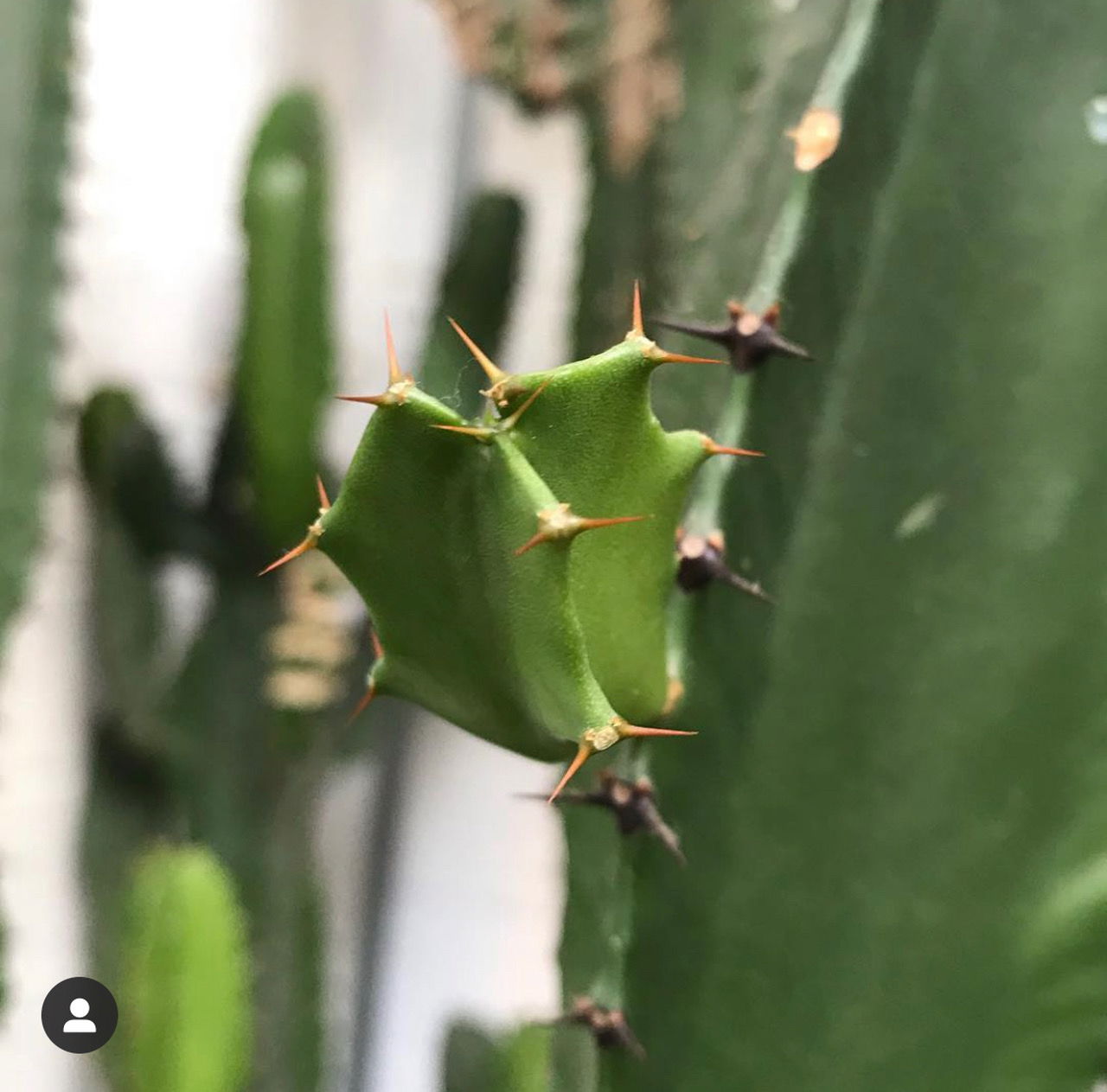
Euphorbia trigona
Contents
- Top Tips
- Location, Water, Humidity & Fertilisation
- Common Issues
- Origins, Temperature, Propagation, Repotting & Toxicity.
Need the answer to a specific plant query? Book a 1-to-1 video call with Joe Bagley, the website's friendly author to overcome and address your niggling problem! Available on iMessage, WhatsApp, Facebook Messenger & more.
Top Tips & Info
- Care Difficulty - Easy
- Provide a bright location with around a few hours of sunlight per day. Recently purchased specimens must build up their tolerance and exposure to the sun over the course of the next eight weeks to avoid sun-scorch.
- African Milk Trees must endure periods of droughts between waters - if you're stuck with when to water it, think of the ukhouseplants' phrase of 'Drenches Between Droughts'.
- Fertilise using a 'Houseplant' or 'Cactus' labelled feed every six waters throughout the year.
- Repot every three years during the spring, using a 'Cactus & Succulent' labelled potting mix. If you're interested in producing a show of blooms, keep the specimen pot bound to restrict the root system. Scroll down to 'Flowers' for more information on this.
- Keep an eye out for Spider Mites, Mealybugs & Scale that'll hide in the plant's cubbyholes.
Location & Light - 🔸🔸🔸
As mentioned above, African Milk Trees are best located in a bright location with a splash of morning or evening sun. The warmth and light from the sun will considerably increase the chance of summer blooms, as areas with near-constant temperatures all year round will stunt the specimen's growth. A few hours of off-peak sunlight will be highly beneficial for the plant, as it’ll significantly reduce the risk of over-watering and root rot. Due to the species' intolerance to low light, avoid placing one in areas where a newspaper can’t be read without the use of artificial light.
Water - 🔸
This plant will require the ukhouseplants saying of 'drenches between droughts'. Not only will continuous soil moisture ruin their root systems, but it'll also increase the risk of a rotten stem which essentially will destroy the plant. Allow all of the soil to thoroughly dry out in between waters in the growing period, reducing this further in the autumn and winter. Under-watering symptoms include a shrivelled stem, yellowing leaves, little to no growth and dry, crispy patches forming on the leaf edges. These issues are usually caused by too much light/heat or forgetfulness. Remember, the brighter the location, the more watering you'll need to do. Over-watering symptoms include a weakened or rotten stem, no new growth, yellowing lower leaves and eventual plant death. The differences between under and over-watering can be very similar, with a rotten root ball or stem being the obvious difference.
Humidity -
This is not a necessity; however, a quick hose down from time to time will hydrate the leaves and wash away dust or potential pests.
Fertilisation - 🔸
Fertilise once every six waters using either a 'Cactus & Succulent' or a 'Houseplant' labelled Fertiliser. As African Milk Trees naturally grow in nutrient-leached soils, forgetfulness of regular feeds won't be a serious detriment to their health. Never directly apply a 'ready-to-use' (RTU) without a pre-water first as this may lead to the burning or roots.
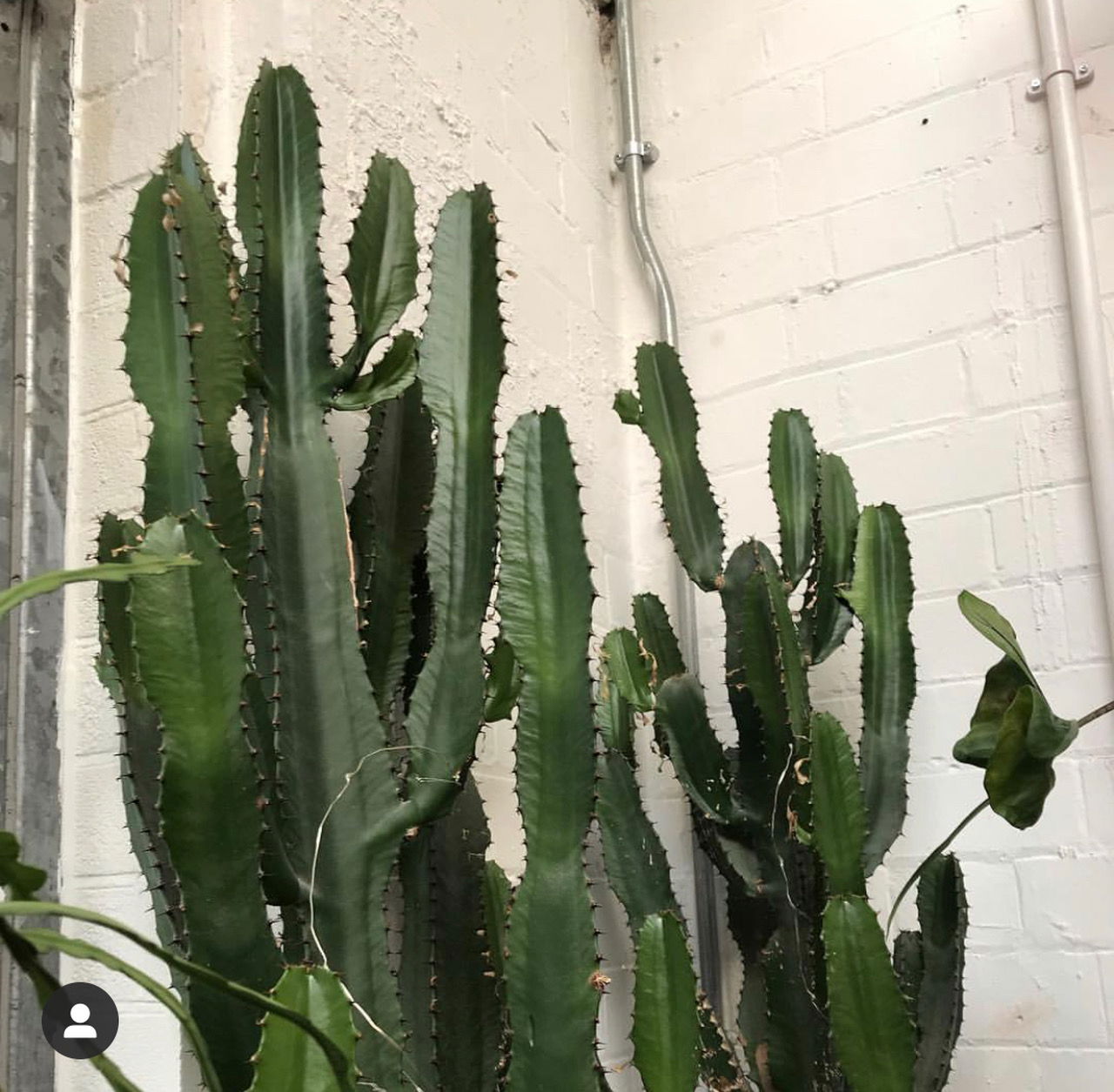 African Milk Trees are the perfect statement specimen for a bright location, and even better for those who forget to water them!
African Milk Trees are the perfect statement specimen for a bright location, and even better for those who forget to water them!
Common Issues with African Milk Trees
Curled leaves and dried brown edges are the result of too little water and over-exposure to the sun. Although this species can naturally do well in sun-filled locations, those that haven't acclimatised to the harsh rays will show signs of sun-scorch and environmental shock. Prolonged exposure will significantly speed the process of dehydration, so consider transplantation into a bigger pot in the spring to wrap the roots around moister soil.
Although gradual leaf loss is accepted as part of maturity, the browning or yellowing of leaves could be a sign of over-watering. Remember to allow all of the soil to dry out in between waters, especially during the height of winter.
Root rot is a common issue with specimens sat in too moist or waterlogged soil for long periods. Symptoms include rapidly yellowing leaves, stunted growth and a rotten brown base. Take the plant out of the pot and inspect health below the soil line. If the roots sport a yellow tinge, you're good to go, but if they're brown and mushy, action must be taken immediately. More information about addressing root rot can be found on this link.
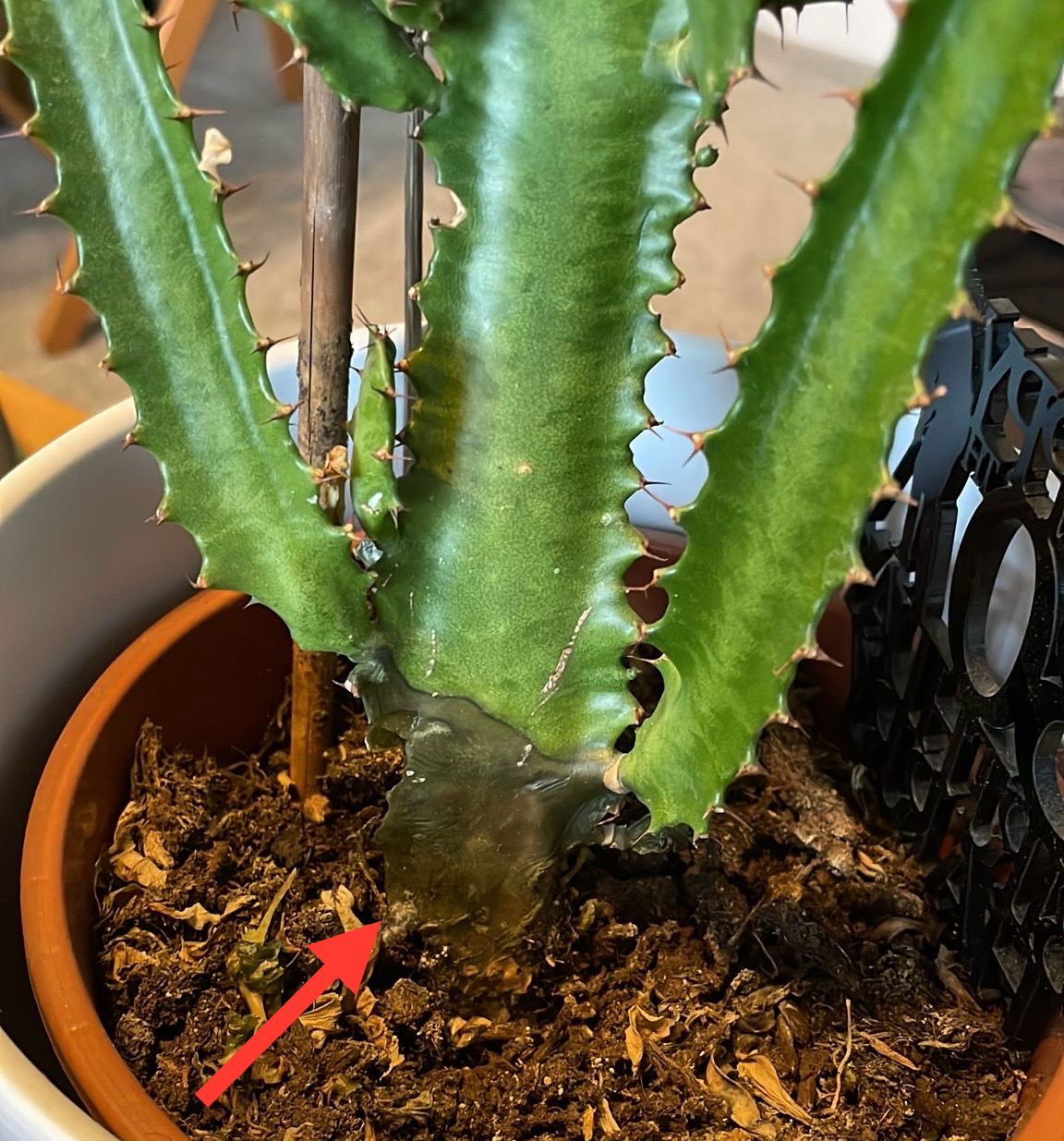 If your Euphorbia's has a brown stem that has rotted fully through, we would recommend taking smaller stem cuttings across the foliage above to 'restart' a fresh root system. Scroll down to the next image to to learn more. Note: 'Corking' is a natural part of a Euphorbia's life which does NOT mean it's dying or rotting. Symptoms of corking are a brown, HARDENED base and 'scabs' developing across the foliage.
If your Euphorbia's has a brown stem that has rotted fully through, we would recommend taking smaller stem cuttings across the foliage above to 'restart' a fresh root system. Scroll down to the next image to to learn more. Note: 'Corking' is a natural part of a Euphorbia's life which does NOT mean it's dying or rotting. Symptoms of corking are a brown, HARDENED base and 'scabs' developing across the foliage.
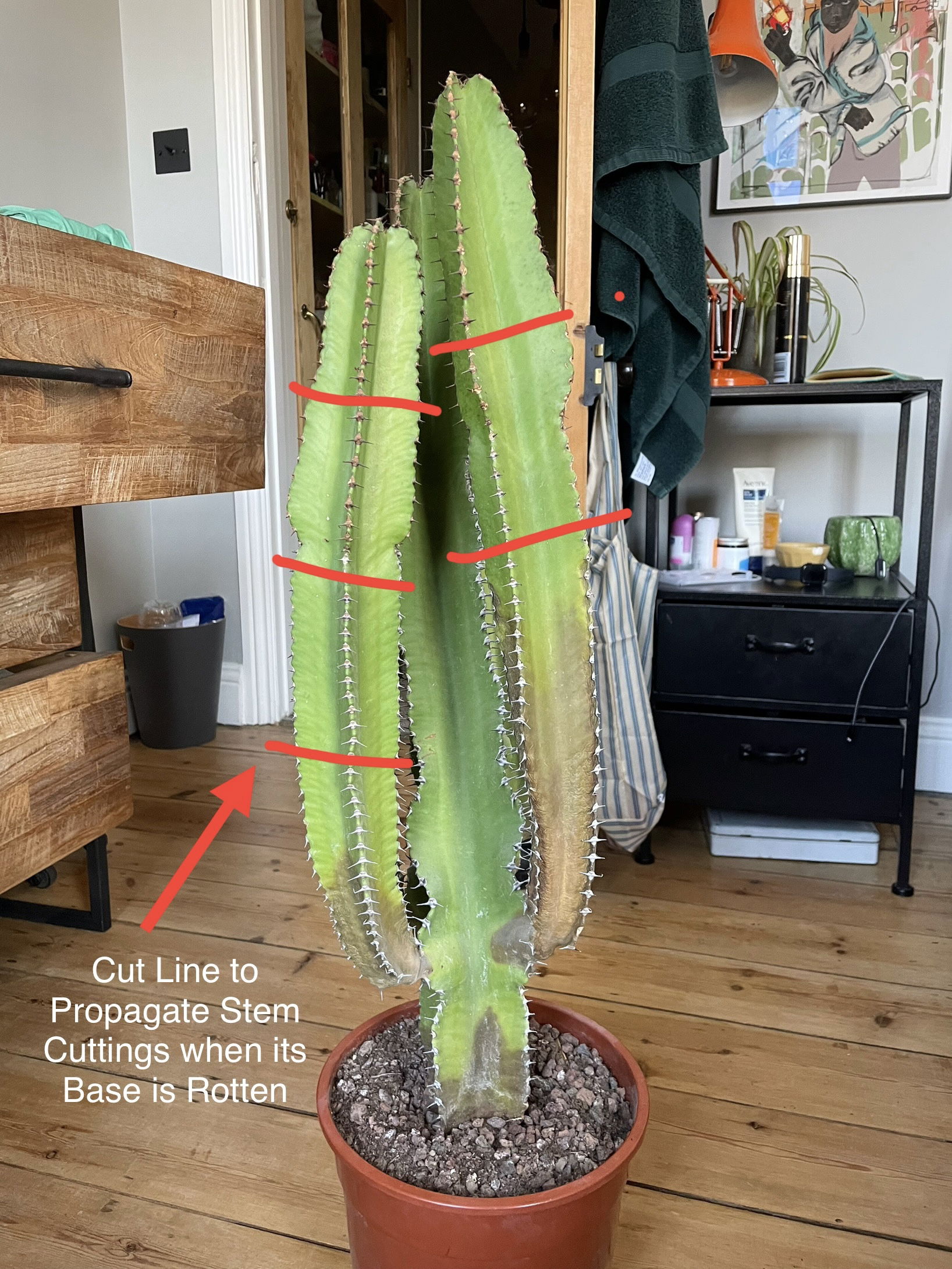 The best way to save a Euphorbia trigona (African Milk Bush) that has a rotten base is by propagating the healthy stem into six-inch sections. Scroll down to 'Propagation' to learn more. Directly pinpointing yellow leaves is rather hard due to the many different issues that could be at fault. Problems include watering-related abuse, too much or too little light, and fertilisation issues. If you'd like to speak to ukhouseplants regarding this issue, don't be afraid to book a 1-to-1 call with Joe Bagley to help guide you through the step-by-step process!
The best way to save a Euphorbia trigona (African Milk Bush) that has a rotten base is by propagating the healthy stem into six-inch sections. Scroll down to 'Propagation' to learn more. Directly pinpointing yellow leaves is rather hard due to the many different issues that could be at fault. Problems include watering-related abuse, too much or too little light, and fertilisation issues. If you'd like to speak to ukhouseplants regarding this issue, don't be afraid to book a 1-to-1 call with Joe Bagley to help guide you through the step-by-step process!
Never allow temperatures to dip below 12ºC (54ºF) as irreversible damage may occur in the likes of yellowed foliage and weakened growth. If this happens, remove the severely affected areas and immediately improve growing conditions - never cut through softened yellow growth, and only around brown, crispy squares. As rehabilitation can take several months because of its slow-growing nature, be sure to provide a stable location with better growing conditions to speed this process.
Origins
Philip Miller first described the species back in 1768, using the Latin word for 'triangular' (trigona) which refers to the three-sided phylloclades (leaves that grow on top of each other to form a stem structure). The genus, Euphorbia, was first penned by Carl Linnaeus in 1754, honouring 1st-century Greek physician, Euphorbos. The species' nickname, the African Milk Tree, refers to the latex-like sap that gets secreted when an open wound occurs (often through damage or propagation). The white fluid will eventually callous over the wound, reducing the risk of a bacteria infection.
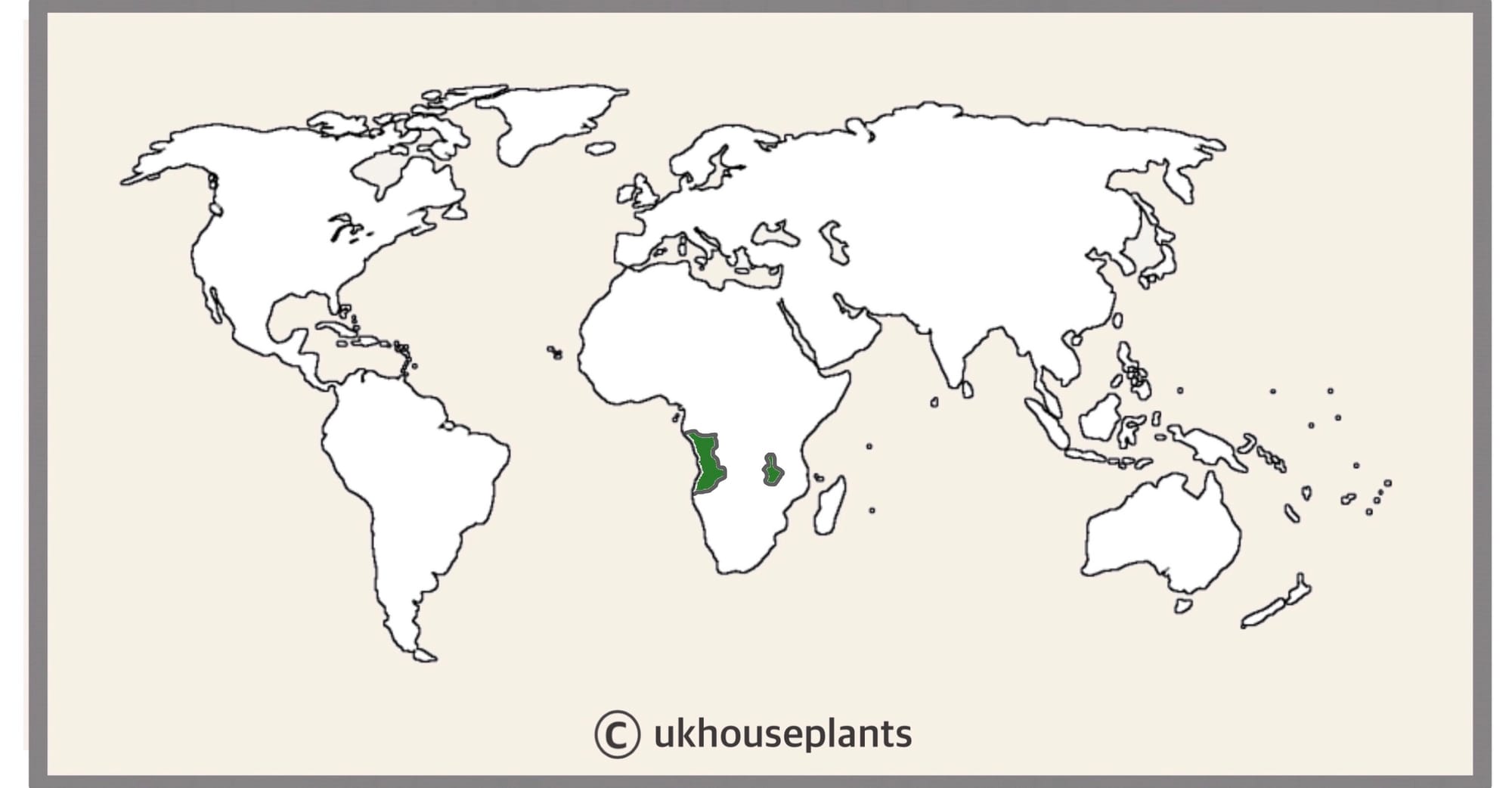
Temperature
12° - 32℃ (54° - 90℉)
H1b (Hardiness Zone 12) - Can be grown outdoors during the spring and summer in a sheltered location whilst nighttime temperatures are above 12℃ (54℉), but is fine to remain indoors, too. If you decide to bring this plant outdoors, don't allow it to endure more than an hour of direct sunlight a day as it may result in sun-scorch. Regularly keep an eye out for pests, especially when re-introducing it back indoors.
Spread
The overall size can be up to 2m (6ft) in height and 0.6m (2ft) in width. The ultimate size will take between 8 - 10 years to achieve when repotted every few years, with several new leaves unfurling per annum. If you're looking for a large statement plant for a sun-filled location, this species is the one for you!
Pruning & Maintenance
Remove yellow or dying leaves, and plant debris to encourage better-growing conditions. While pruning, always use clean scissors or shears to reduce the chance of bacterial and fungal diseases. Never cut through yellowed tissue as this may cause further damage in the likes of diseases or bacterial infections. Remember to make clean incisions as too-damaged wounds may shock the plant, causing weakened growth and a decline in health.
Propagation
Via Seed or Stem Tip Cuttings.
Stem Cuttings (Easy to Moderate) - This method is an easy way to duplicate the original plant. Stems that are at least 8cm (3 inches) in height and part of an established plant are most successful. To avoid making a mess of the serrations, use a clean pair of scissors and cut 8cm down from the stem's end, dipping the wound in water and then into rooting hormone to speed the propagation. Rooting can take in the range of between two to eight weeks, depending on environmental factors and the cutting's quality. We recommend using a 'Cactus & Succulent' labelled potting mix, with a pot that has adequate drainage to avert the risk of blackleg. Provide a bright, warm setting of around 18℃ (64℉) with relatively moist soil, but be sure to allow the top half to dry out in between waters. You'll know if propagation is successful as the leaves will stay green and firm, along with small roots developing from the callous (dried wound). New foliar growth will emerge from the nodes after around twelve weeks, but it may take longer if the conditions aren't optimal. After a month of solid new foliar growth, transplant into a slightly bigger pot and treat it like a mature specimen with the care tips provided above.
Flowers
African Milk Trees will rarely flower in their lifetimes; however, for the interest of this section, their inflorescence largely resembles a disk-like shape with thin, broad bracts.
Repotting
Repot every three to four years in the spring, using a 'Cactus & Succulent' labelled potting mix and the next sized pot with adequate drainage. African Milk Trees are far better potbound for several years due to the heightened risk of root rot and repotting-issues (like transplant shock) - so only repot if you feel it's wholly necessary.
Hydrate the plant 24hrs before tinkering with the roots to prevent the risk of transplant shock. For those situated in a darker location, introduce extra amounts of perlite and grit into the lower portion of the new soil to downplay over-watering risks. Click here for a detailed step-by-step guide on transplantation, or via this link to learn about repotting with root rot.
Book a 1-to-1 video call with Joe Bagley if you'd like a personal guide to repotting your houseplant. This will include recommending the right branded-compost and pot size, followed by a live video call whilst you transplant the specimen for step-by-step guidance and answer any further questions!
Pests & Diseases
Keep an eye out for mealybugs, spider mites, scale, thrips whitefly & root mealybugs that'll locate themselves in the cubbyholes and undersides of the leaves, with the exception of the latter two in the soil. Common diseases associated with African Milk Bushes are root rot, leaf-spot disease, botrytis, rust, powdery mildew & southern blight - click here to learn more about these issues.
Toxicity
This plant is classified as poisonous; if parts of the plants are eaten, vomiting, nausea and a loss of appetite could occur. Consumption of large quantities must be dealt with quickly; acquire medical assistance for further information. The sap can also cause dermatitis and skin allergy to sensitive individuals, so be sure to wear gloves when handling.
Retail Locations
Blue Diamond, IKEA & Online Stores.
Book a 1-to-1 Call with Joe Bagley
If you need further advice with your houseplants, book an advice call with ukhouseplants' friendly and expert writer today! This can be done via a video or audio call on most apps, including Facebook, FaceTime & Skype. A ten-minute call costs £5.99 (US$7), or £15.99 for thirty minutes. You can ask multiple questions, including queries on plants, pests, terrariums, repotting advice and anything in between. Please consider supporting this service to keep ukhouseplants thriving!